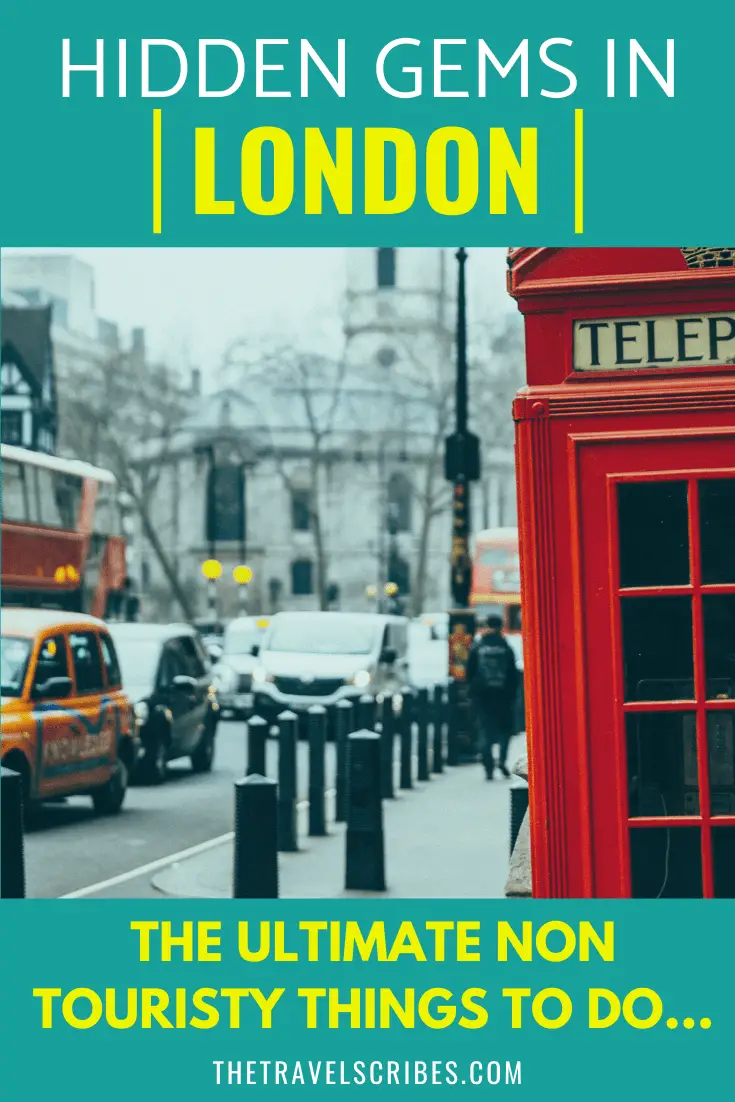Looking for the best things to do in London, but you’ve already checked off all of the major attractions and iconic London landmarks like Trafalgar Square or Covent Garden? Well, luckily as a born and bred Londoner, I have a few ideas! That said, to create a cracking list of the best non-touristy things to do in London, we asked some leading travel bloggers to send their secret spots. So, if you are wanting some inspiration on what to do when you’re next in the big smoke, check out our list of the top 21 must-visit hidden gems in London.
Skip ahead
Our Top 10 non-touristy things to do in London
Now you’ve got a laundry list as long as your arm, full of the best non-touristy things to do in London to read ahead. But, if you had to absolutely pin us down and select just ten hidden gems in London, these are the ones that make the list:
- House of MinaLima
- Little Venice
- Leadenhall Market
- Hampstead Heath Pergola and Hill Garden
- Highgate Cemetery
- Brick Lane
- The Banqueting House
- Kayak Tour of the Thames
- Eat Pie, Mash and Liquor
- All Hallows by the Tower Church
Read next: Want to get the best London quote for your amazing photos at these hidden gems? Check out these awesome quotes about London.
Gods Own Junkyard
Explored by Liliane from My Toronto, My World
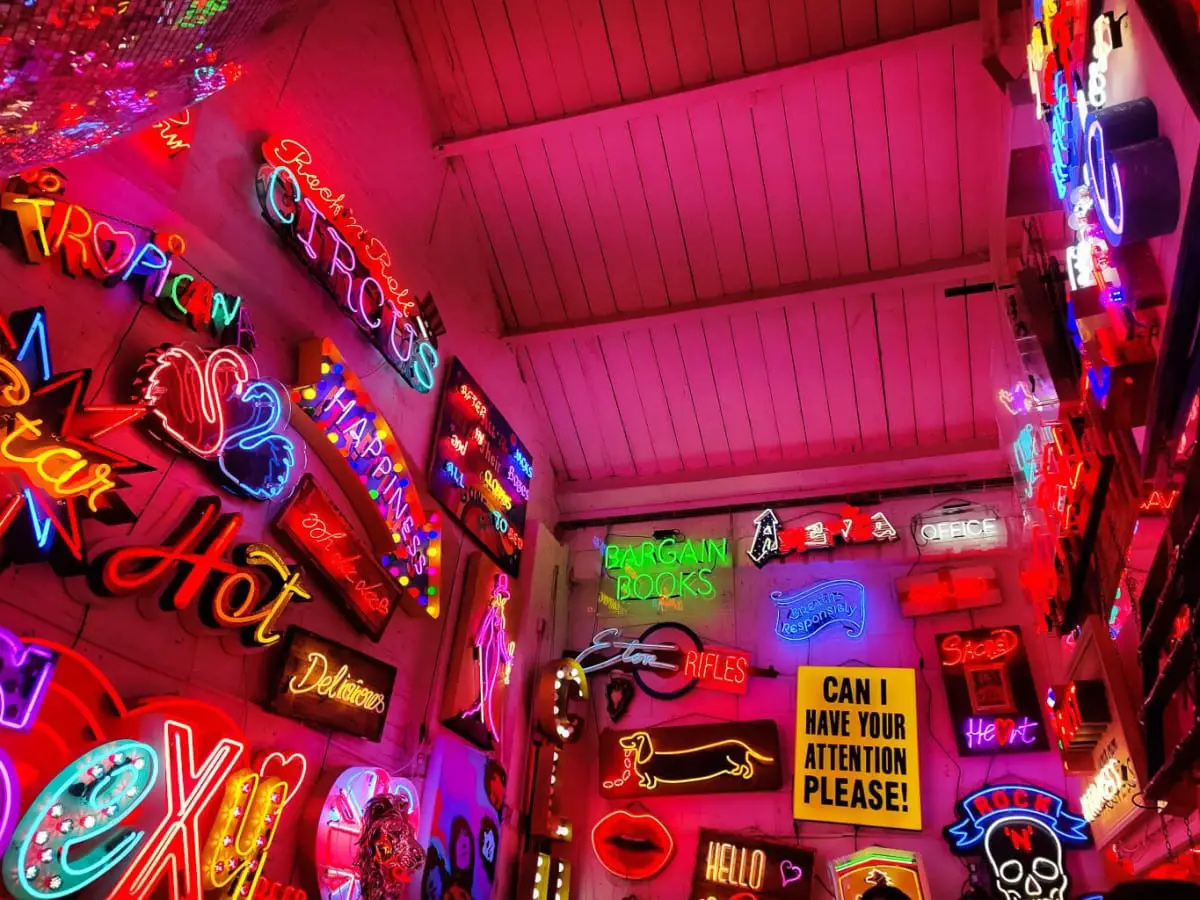
London is full of amazing things to do and one of the best hidden gems in London is Gods Own Junkyard.
The store is the brainchild of Chris Bracey who was an artist who specialised in neon light creations. Gods Own Junkyard is a neon sign heaven, filled from top to bottom with different coloured, different sized neon signs that will grant all your photography wishes. It’s easily one of the most instagrammable places in London which you can tell by the number of people/groups having mini photo shoots inside this secret London gem.
It’s a smaller space and with people aiming for the perfect picture it does get busy and so I’d recommend going earlier in the day to try to avoid some of the crowds. It’s important to be respectful and make sure that everyone gets access – this means don’t hog any of the spots for longer periods of time!
Gods Own Junkyard is open to the public on the weekend. On Fridays and Saturdays it’s open between 11am and 9pm and on Sundays it’s open between 11am and 6pm. It’s completely free to visit but you can buy something to support the business either from the store or from the cafe within the store.
Location: Unit 12, Ravenswood Industrial Estate, Shernhall St, Walthamstow, London United Kingdom
Open: Fridays and Saturdays 11.00am to 9.00pm, Sundays 11.00am to 6.00pm – closed during the week!
Highgate Cemetery
Explored by Paul from Anywhere We Roam
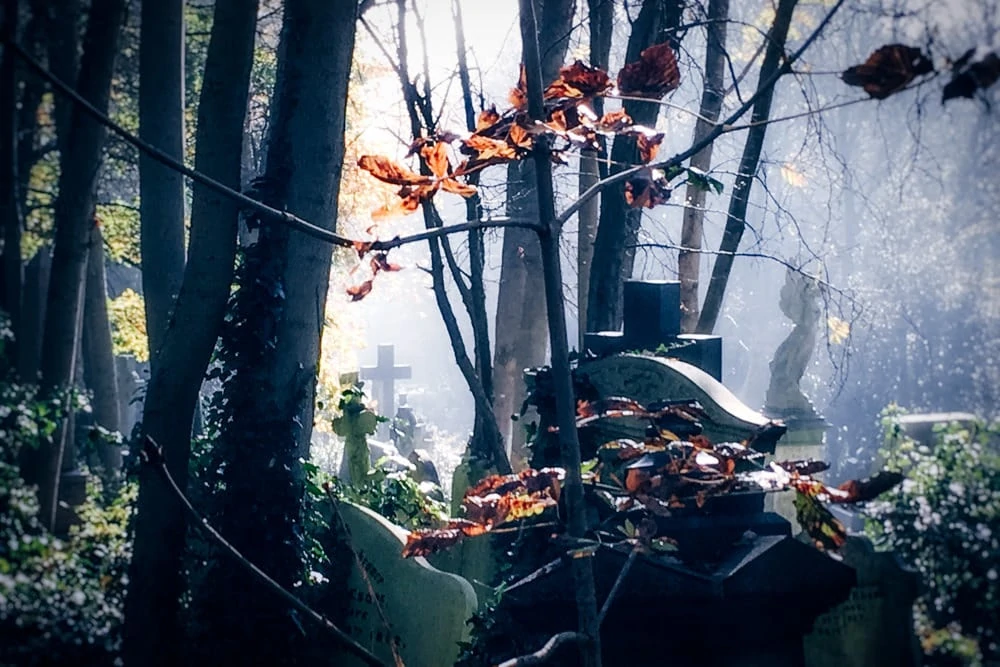
Highgate Cemetery in north London originally opened in 1839 as a response to London’s severe lack of burial sites. With its unique Victorian gothic architecture and a prime elevated position overlooking London, it soon became the hottest place to be buried for the wealthy upper class.
Healthy investment by London’s elite was encouraged, which saw staggering monuments occupy the small hilly plot of land. By the start of the First World War, however, Britain lost its sympathy with high-end burials and Highgate cemetery fell into serious disrepair.
Overgrown trees and decaying Victorian gothic monuments gave Highgate a creepy feel which made it a pop fiction icon for ghost stories, mysteries and other other-worldly anecdotes.
Now under the guardian of a group of charities, Highgate Cemetery is atmospheric and beautiful and much less creepy. On a stroll through the cemetery you’ll find some big names now calling this place home. Douglas Adams, author of Hitchhiker’s Guide to the Galaxy has a subtle gravestone, while Patrick Caulfield’s simply reads “DEAD.” The most famous resident is Karl Marx with his huge bust.
The cemetery is split into 2 sections. The East cemetery, where Karl Marx is buried, is in a more orderly condition and visitors can stroll around on their own after paying a small entrance fee (4.50 GBP/5.50 USD). The West cemetery contains the most impressive architectural features and the still overgrown sinuous paths create a far more evocative feel.
Location: Swain’s Lane, Highgate, London
Open: 10.00am to 5.00pm daily
House of MinaLima
Explored by Laura from What’s Hot?
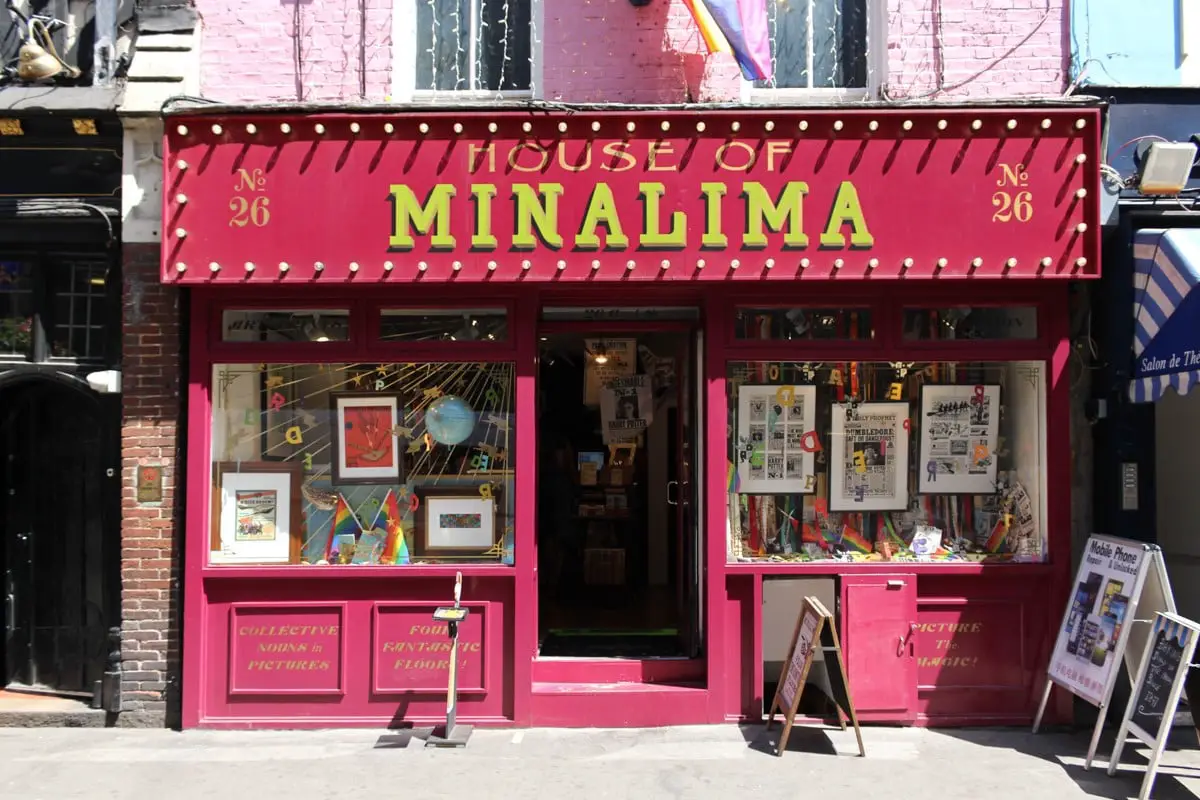
Right in the heart of London’s Soho and a stone’s throw away from the Cursed Child theatre is House of MinaLima, a free Harry Potter gallery in London.
Whilst many won’t be familiar with the names Miraphora Mina and Eduardo Lima, Harry Potter fans will undoubtedly be familiar with their work. This pair are the graphic designers for the Harry Potter and Fantastic Beasts films including iconic items such as the Marauders Map, the Daily Prophet, the Quibbler and more.
The gallery showcases the very best of their work and quickly reveals just how intricate a world the Wizarding World of Harry Potter is. Many of the items they’ve designed won’t be ones you’d really notice in the films, but without them the magical world portrayed would be much less vibrant. Some of the designs by Mina and Lima that can be viewed at the House of MinaLima include the wrappers for all the sweets in Honeydukes, the “WANTED” posters for Azkaban escapees and the covers of the Hogwarts textbook.
It’s a tall, narrow building with winding staircases and creaky floorboards. Pretty much every wall, floor and ceiling are covered in their designs and the full floor Marauders Map is something not to miss!
This gallery is an absolute must for those looking for all things Harry Potter in London and, again, this gallery is completely free. What’s more, you can buy a copy of every single print on show, with different price tiers depending on what ink is used, so you can take home some of these magical designs on your way out.
Location: 26 Greek St, Soho, London
Open: 10.30am to 7.00pm daily
Interested in a Harry Potter guided tour? Check out this option.
Brick Lane
Explored by Jamie & Ivana from Wander In Two
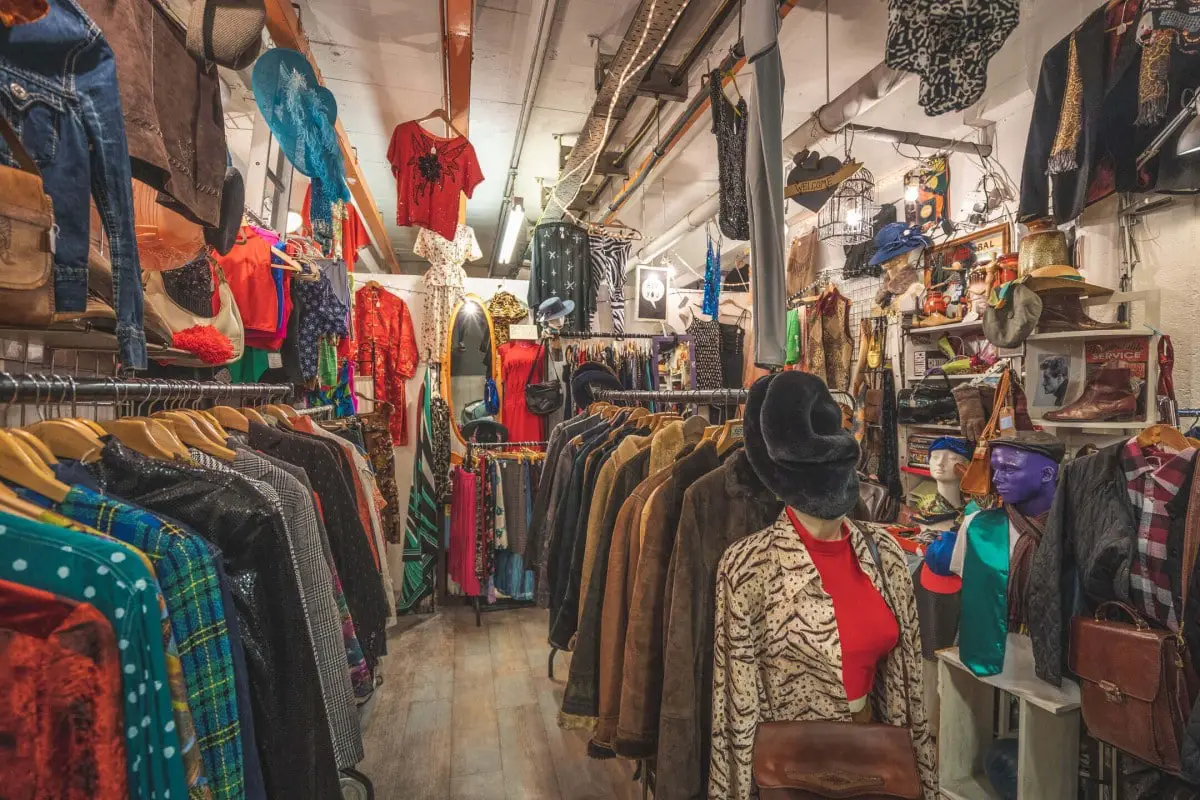
Brick Lane may not be referred to as a hidden gem, especially by London locals, however, it can often be overlooked by anyone visiting the nation’s capital city.
Having lived in London for five years, we often found ourselves visiting Brick Lane every other Sunday morning to soak up the authentic London atmosphere.
Also known as the Truman Market, Brick Lane is actually made up of 5 different markets which you can find nestled in the nitty-gritty of the iconic East End of London.
If you are there as a couple, with family or friends, or even if you just fancy a solo stroll or peruse, then you will find that the 5 markets will literally cater to all tastes.
We would suggest you head to the Sunday UpMarket first, which will literally grab you by the nostrils as you pass by anyway, to enjoy some of the delicious street food on offer.
From there you should head down to the depths of the Vintage Market to see if you can find nostalgic clothing from your past before taking a hop, skip and a jump over to the Backyard Market to check out the arts and crafts on offer.
If you are into looking for antiques to take home as a souvenir or to buy as a gift, then you will be delighted to know there are some diamonds in the rough at the Brick Lane Tearooms.
To round up your experience you should pop your head into the Boiler House and grab another snack from the road. There are lots of international dishes on offer so no one should leave Brick Lane with an unsatisfied stomach.
Location: Brick Lane, London, United Kingdom
Read next: Thinking of other places to visit in the UK? Why not check out the best things to do in Cornwall…
Kayak along the Thames
Explored by Eniko from Travel Hacker Girl
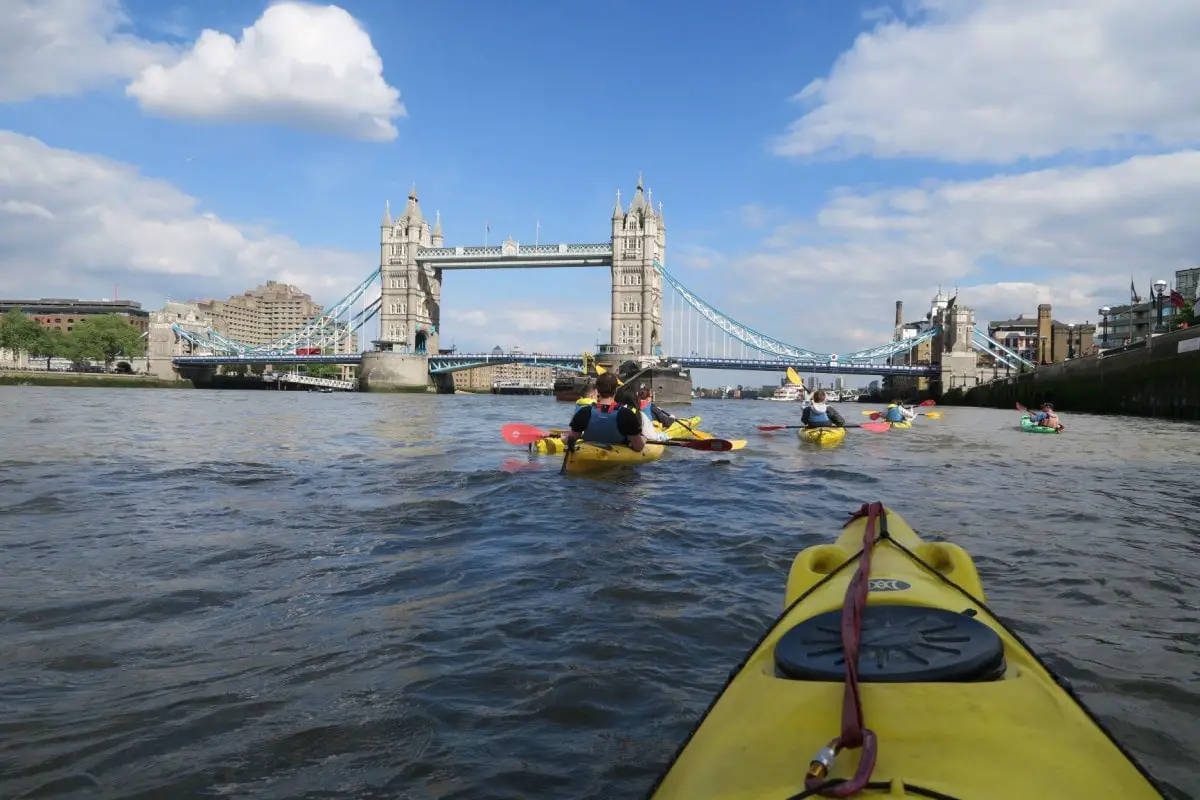
Sightseeing in London by kayak is a really unique experience. You will be able to see all the major attractions from the surface of the iconic river Thames.
The tour follows the tidal flow making paddling all that much easier. The section between Greenwich and Battersea Park is full of famous landmarks. You will pass by Cutty Sark, the Tower of London, HMS Belfast (a light cruiser from the Royal Navy that served in World War II), St. Paul’s Cathedral, the London Eye, Houses of Parliament and the Mi6 building. The highlight of the trip is paddling under Tower Bridge.
You will even have the chance to get your photo taken by the guides. You can keep this epic shot, which will be a nice memory of the good times you had in the city. During this trip, you will cover 17 km in under 3 hours. It is also possible to do this tour in the evening and see what the city looks like with the lights on.
Either way, you will have an unforgettable experience if you decide to explore London by a kayak.
Little Venice
Explored by Nisha from Nerdy Footsteps
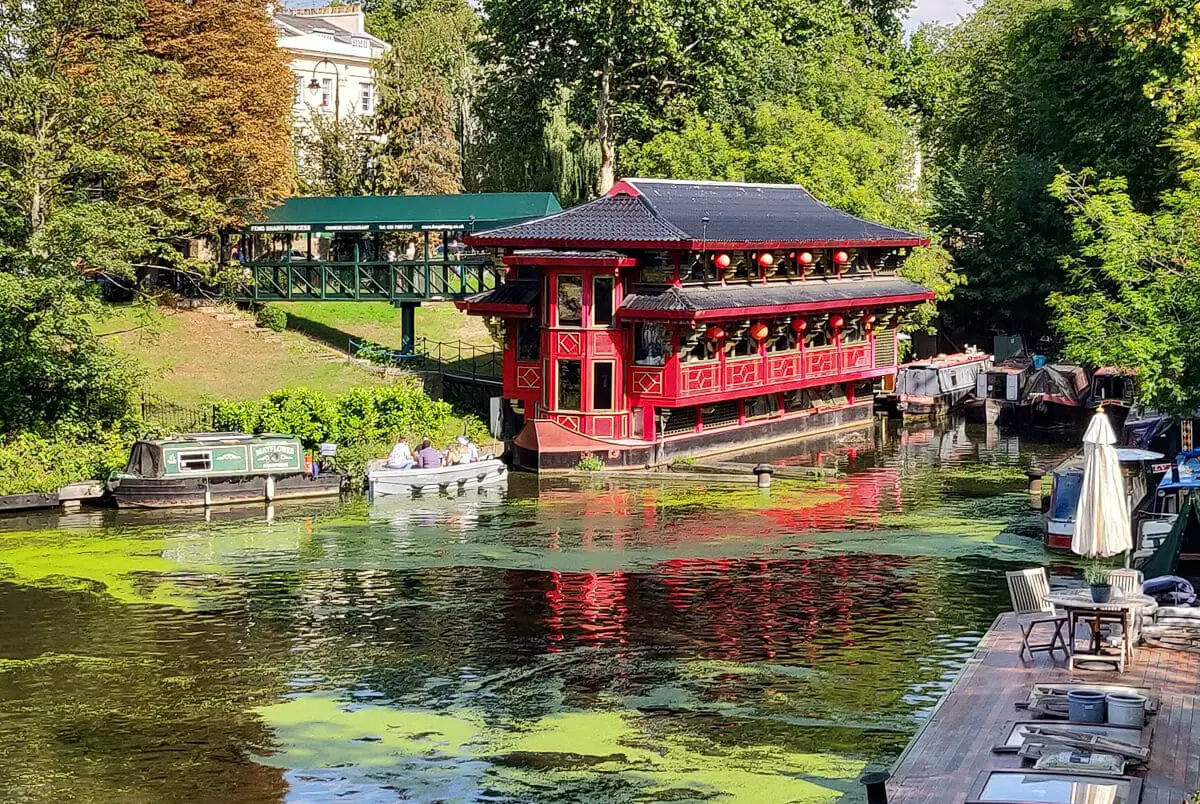
Just a few minutes away from one of the busiest train stations in London, Paddington, Little Venice feels like a different world altogether. This lush and green area deserves a spot on your secret gems in London list.
This primarily residential area has some waterways and canals running through it and hence the name. While Little Venice doesn’t resemble Venice much, it certainly adds a new chilled flavour to the bustling city of London.
The waterways and reflections from the greenery around make the view fresh and calming. There are many cafes, wine shops, and bistros and restaurants in this area. You will even find a lot of cafes and restaurants on the bridges on the canal.
While you can take a boat trip in the canals and feel like you are in Amsterdam, I would recommend strolling on the pedestrian path along the canal. Walking around the canal, you will find many traditional and quirky boats. Other attractions in the same neighbourhood include Lord’s cricket ground, Regent’s Park, and ZSL London Zoo.
I recommend starting the walk from Paddington train station. Make your way along the canal and follow it all the way to the Camden Market, where you can sample a huge variety of international food options. It will take about an hour and a half if you stroll at a medium pace, enjoying the views and of course, taking enough photo breaks.
Location: Little Venice
Leadenhall Market
Explored by James from The Travel Scribes
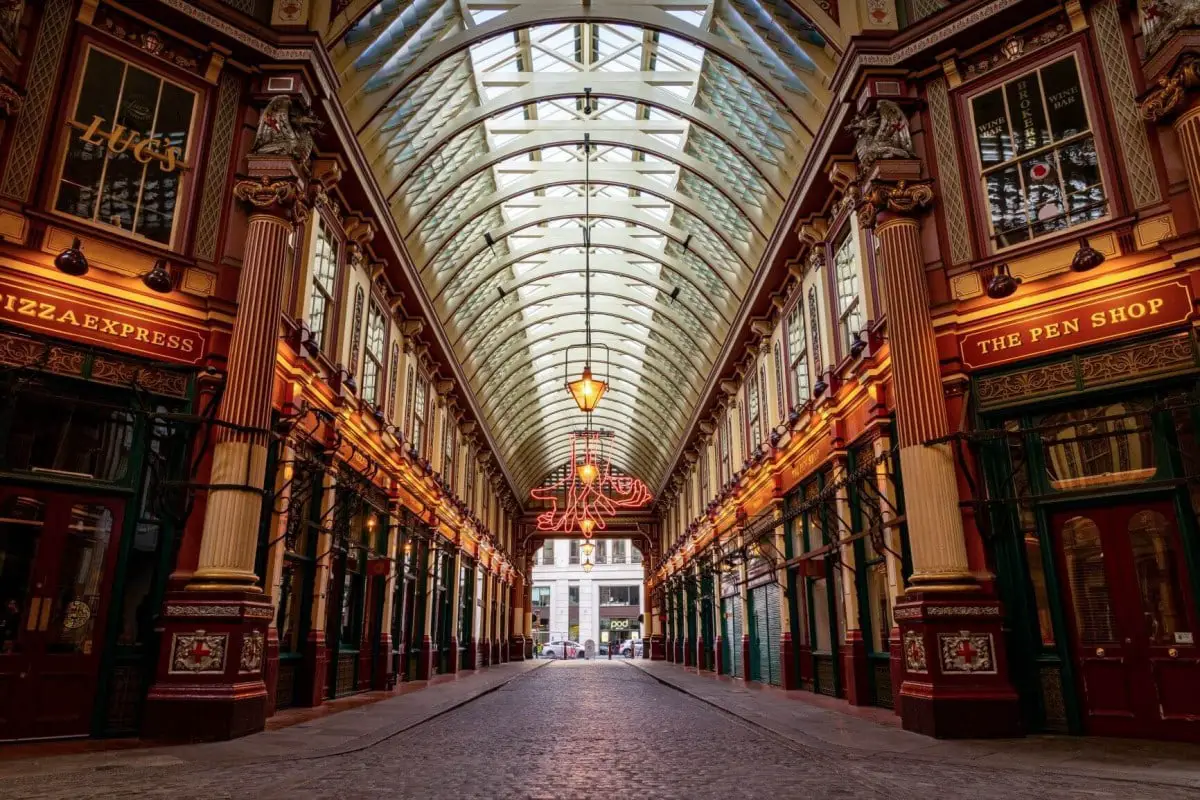
Eminently Instagrammable, Leadenhall Market – which is starting to garner fame due to the ‘gram – is definitely one of the best non-touristy things to do in London. First coming to life as a meat and fish market back in the 14th century, this exquisite covered Victorian building got a new ruby red and green painted roof in 1881, which made it even more appealing to photographers and visitors alike.
Nowadays this market sells a bit more than a side of cod as you’ll find everything from fresh flowers to crusty, stinky cheeses as well as some charming little stores and a smattering of gastro pubs and restaurants. It’s also got another claim to fame as Harry Potter-philes will tell you that the marketplace was home to a few scenes from the movie scenes, as the film location for Diagon Alley where the students went to buy their wands and school books. It was also home to the Leaky Cauldron, a pub featured in the films.
A stone’s throw from iconic places like the Sky Garden or evenly the aptly-named skyscraper, the Gherkin, Leadenhall market is a great London hidden gem, and definitely one to visit as part of your London itinerary.
Location: Gracechurch St, Langbourn, London
Open: Mondays to Thursdays – open 24 hours, Friday 10.00am to 6.00pm, weekends – closed!
Eat Pie, Mash and Liquor at Manze’s
Explored by Sarah from A Social Nomad
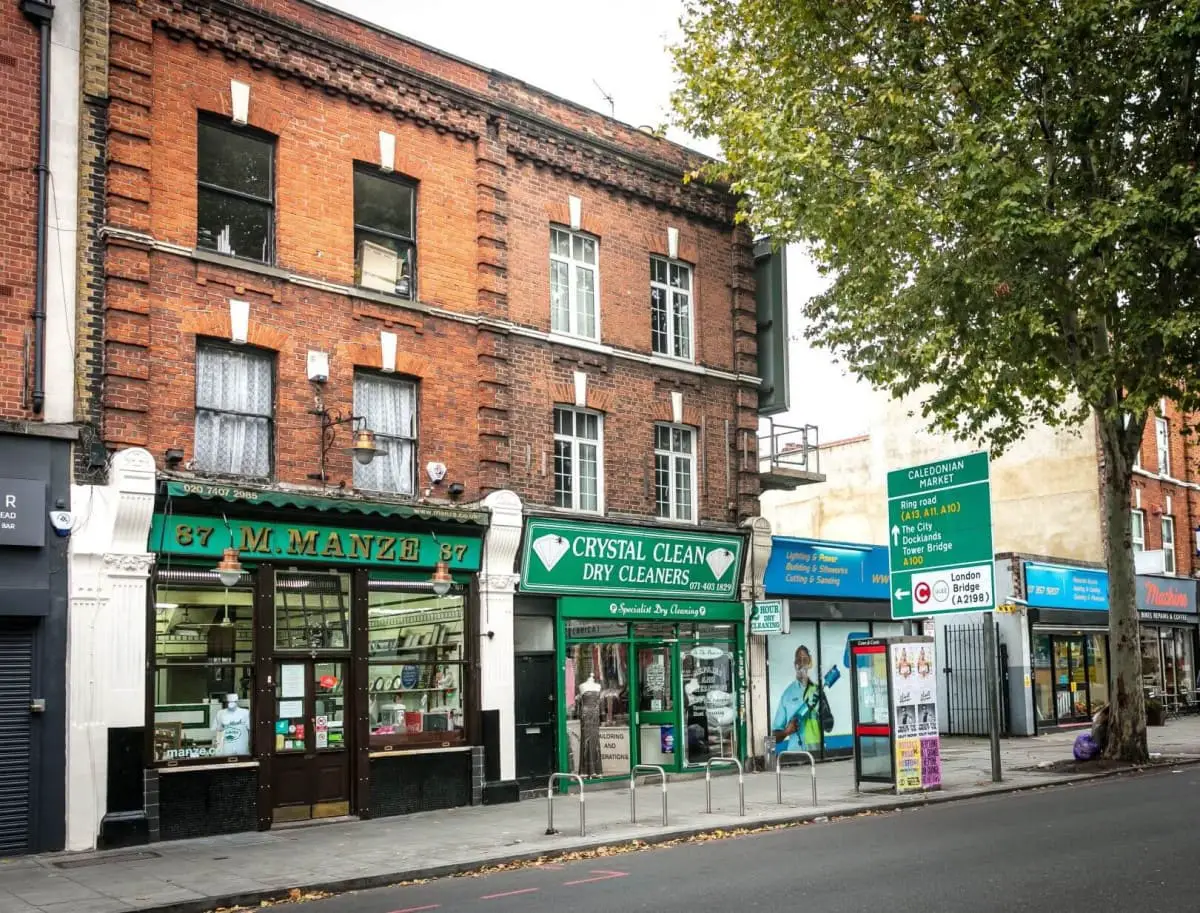
There’s one thing that you’ll want to do when you visit London and that’s eat street food. And it should be the original London street food.
England’s capital grew around the River Thames, which back in the 18th century was teeming with marine life, especially freshwater eels. That and a plentiful supply of cheap potatoes led to what was London’s original street food – pie, mash and liquor. The pies were filled with eels, mashed potato was added and the dish was finished with a hearty splash of “liquor” – a sauce made from the eel cooking water and parsley.
As street food vendors became better off, they moved into premises – and London’s oldest original pie shop is still to be found at Manze’s in Bermondsey.
Today the eels have been replaced with minced beef (and there are vegetarian options too), but the mashed potato is still very much in evidence, as is the parsley sauce, which follows an old family recipe.
This original pie shop is a firm favourite amongst locals – there are definitely more residents than tourists visiting and if you want the proper East End London experience, then once you’ve covered your pie with the parsley liquor, sprinkle it well with salt and vinegar!
Location: 87 Tower Bridge Road, London
Open: Mondays 11.00am to 2.00pm, Tuesday to Thursdays 10.30am to 2.00pm, Fridays 10.00am to 2.15pm, Saturdays 10.00am to 2.45pm, Sundays – closed!
All Hallows by the Tower Church
Explored by Erin from Traveling Thru History
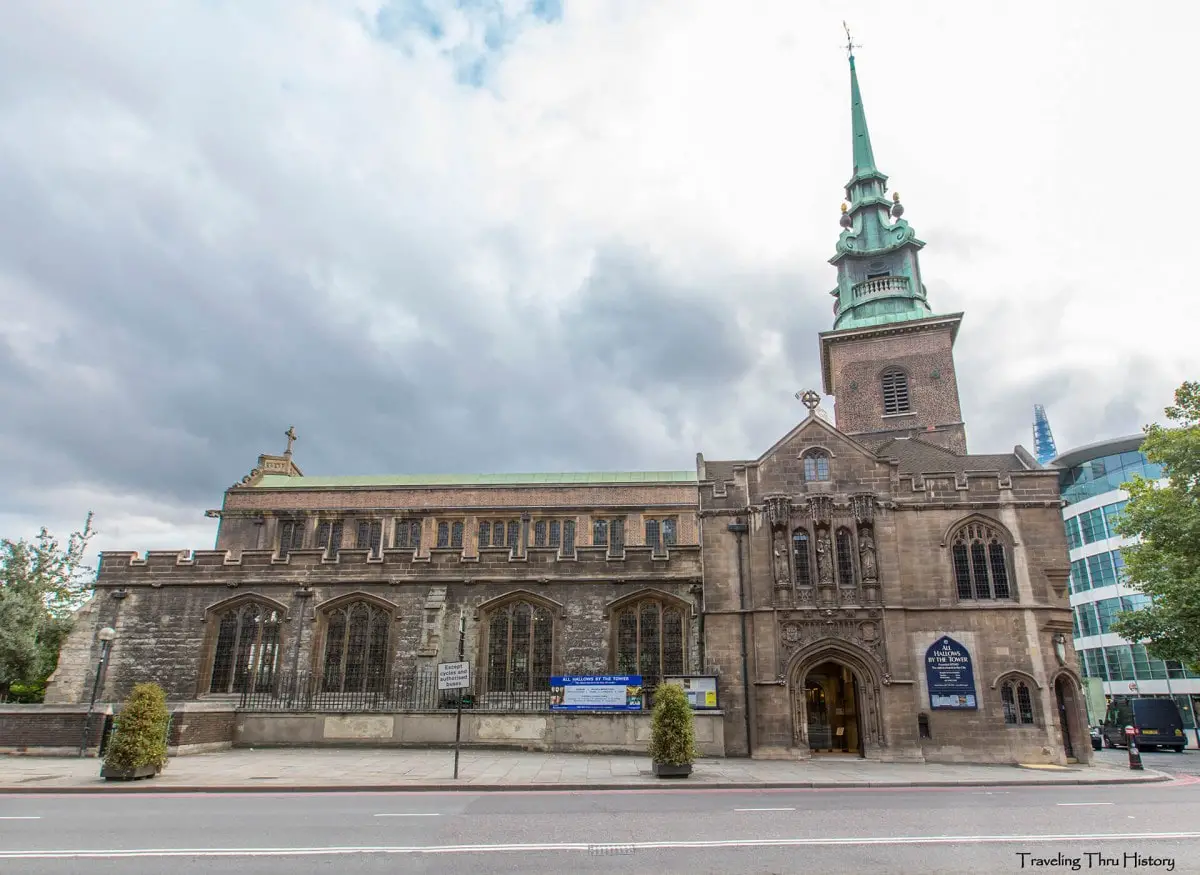
All Hallows by the Tower Church is the oldest church in London. It was built in 675AD, 300 years before the Tower of London was built. Having survived a gunpowder explosion in 1650 and the Great Fire of London in 1666, All Hallows suffered catastrophic damage during World War II. Only the tower and the outer walls survived the bombings during the war, but the rest was rebuilt and rededicated in 1957. Along with the original tower and outer walls, All Hallows contains the oldest surviving Saxon arch in the city of London.
Inside the chapel, visitors will find beautiful stained glass, intricate murals, detailed sculptures and carvings, memorials dedicated to people and events, and a beautiful pipe organ. Underneath the chapel lies a crypt which houses an ancient Roman pavement that was found under the church, a diorama of London during Roman times, church registers dating back to the 16th century, ancient artefacts from the church’s history, small chapels, and an altar from the castle of Richard I that was brought from Athlit Castle in The Holy Land.
Visiting the church is free. They recommend making a donation if the visit is not of a religious nature and charge a nominal fee for an informational pamphlet. Free guided tours are available weekdays from 2pm to 4pm, though visitors should call ahead to ensure there is a volunteer available the day they are visiting.
Location: Byward St, Tower, London
The Operating Theatre and Herb Garret
Explored by David from Delve Into Europe
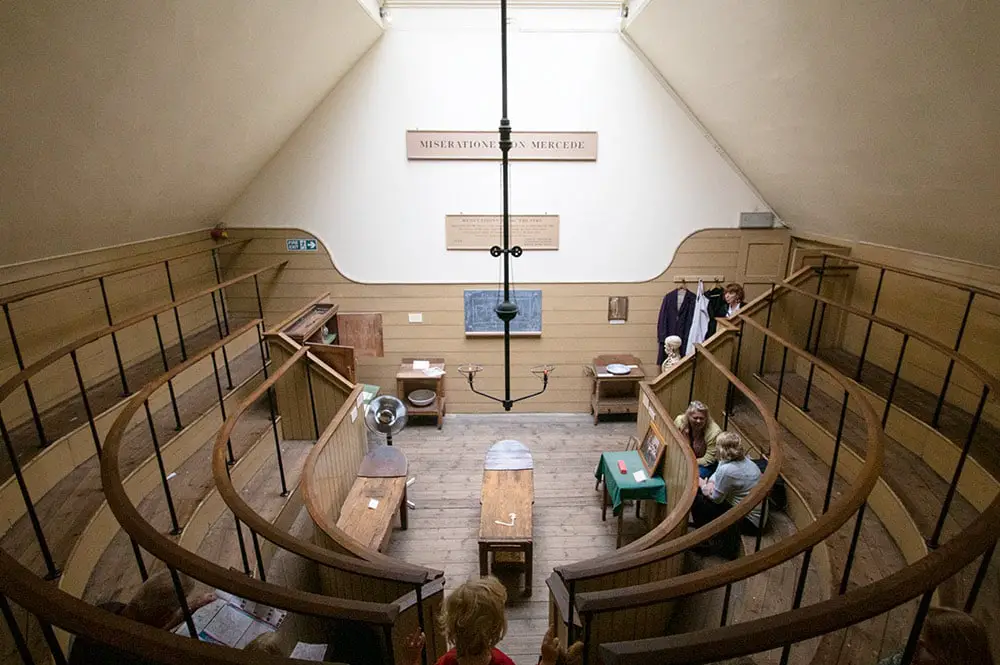
The Old Operating Theatre and Herb Garret is one of the best hidden places in London, located little more than a stone’s throw from London Bridge, one of the most famous bridges in London.
The original St Thomas’ Hospital was built around St Thomas Church, just off what is now Borough High Street. The church was built around 1697, and it remained in use until the early 19th century. At this time, the upper storeys of the tower were used as a storage area for herbs used by apothecaries, and a section of it was converted into an operating theatre, complete with high seating around three sides for observers to get a good view of proceedings, amphitheatre-style.
This is the oldest surviving operating theatre in Europe, indeed the only one from the 19th century. The Theatre itself is kept until the end of the visit – first you explore the fascinating Herb Garret, complete with labelled bottles of tinctures and all kinds of contemporary concoctions. Surgical skills were at best rudimentary – the false leg on display in a glass cabinet in the Herb Garret shows you all you need to know about that.
The first anaesthetic wouldn’t be developed until 1846, so it helped that some of the walls were soundproofed so that patients’ screams couldn’t be heard.
It’s an amazing place to visit because it’s so unique, and it’s also incredibly atmospheric.
Location: 9a St Thomas St, London
Open: Mondays 2.00pm to 5.00pm, Tuesdays to Fridays 10.30am to 5.00pm, weekends 12.00pm to 4.00pm
See the deer in Richmond Park
Explored by Darek and Gosia from DarekandGosia.com
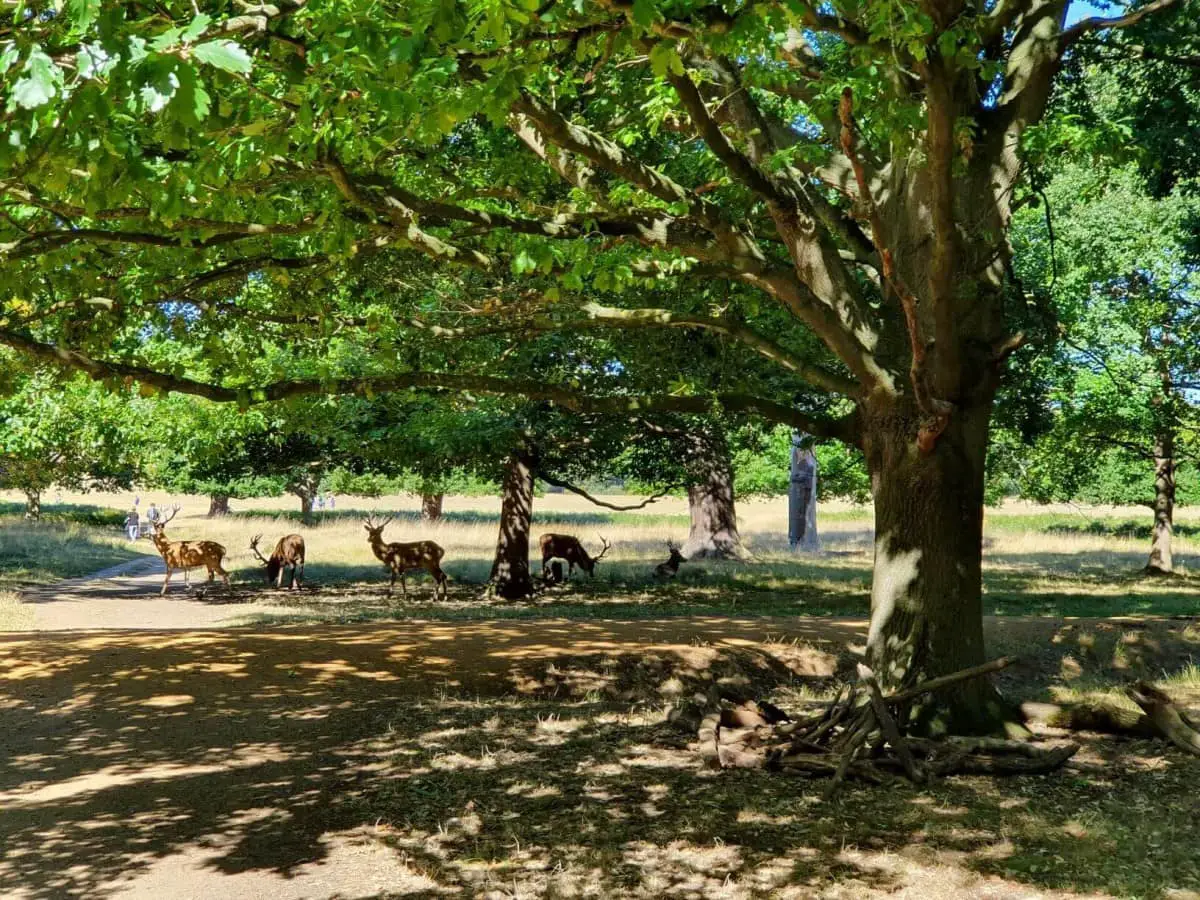
Richmond Park is the largest fenced city park in Europe with an area of up to 955 hectares. And although it is so huge, it does feel like a hidden gem in London! OK, it’s not really hidden – but the fact that it is located far away from busy centre of the capital city, makes you feel like you are in another world.
Richmond Park is located in the south of London and the easiest way to get there is by tube. Take the District Line towards Richmond and get off at the last station. You can get to the park gates after a 20-minute walk.
The park is one of four, and also the largest Royal Park in London. You can find a variety of wildlife in it and in particular admire the magnificent deer. Yes, many people visit just to watch deer in Richmond Park, but it is so massive that you don’t feel crowded at all! Little changed over the centuries – it abounds in old forests with large oaks, vast meadows, hills, tall grasses and natural lakes.
The park has several roads for traffic. Most of the pedestrian paths are gravel roads that lead through wild areas – a perfect place to ride a bike or just go for a picnic. So, is Richmond Park on your list of hidden gems in London?
Bonus: Want to head to another great hidden gem of a park in London? Check out Victoria Park in trendy Hackney. This acclaimed park has a lake, gardens, loads of walks and even a cricket pitch!
Explore Walworth
Explored by Fiona from London Unattached
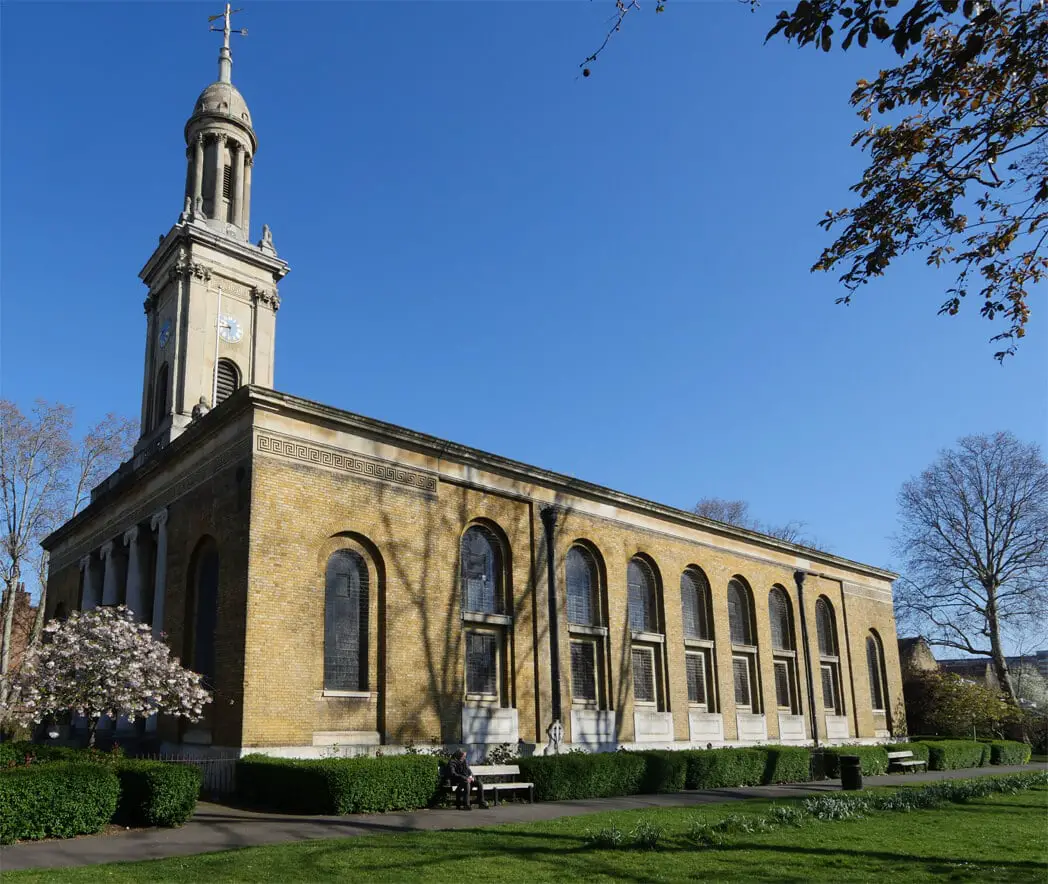
If you ask anyone, even a born and bred Londoner, where Walworth is, they will probably scratch their head and look puzzled before telling you they think it is somewhere in East London. In fact, the small pocket of land that makes up Walworth sits between Elephant and Castle to the north, Kennington to the West and Camberwell to the south.
It is packed full of history, from the site of London’s second zoo and pleasure gardens at Pasley Park to Victorian artisan live-work studios and tenement flats at the Pullens buildings. These were earmarked for demolition in the 1980s but survived thanks to a ‘friendly’ occupation by local people. Today the accommodation is mostly privately owned and not connected with the studios, but there are plenty of artisan businesses still working there and open studios twice a year so everyone can buy something original that was made locally.
The birthplace of Charlie Chaplin and very much a traditional London neighbourhood still, Walworth was bombed heavily during the blitz and as a result you will find classic regency architecture in juxtaposition with 1960s social housing.
Finally, St Peter’s Church, which you might look at and think is from a different part of London altogether, is the first church designed by Sir John Soane, built between 1823 and 1825. A Grade I listed building, it is the little sister to the better-known church at St Pancras, and to Holy Trinity Marylebone.
Top Tip: Interested in the work of Sir John Soane? Then definitely check out the Sir John Soane museum, it’s definitely a bonus addition to the list of best non touristy things to do in London!
The Hardy Tree
Explored by Wendy of The Nomadic Vegan
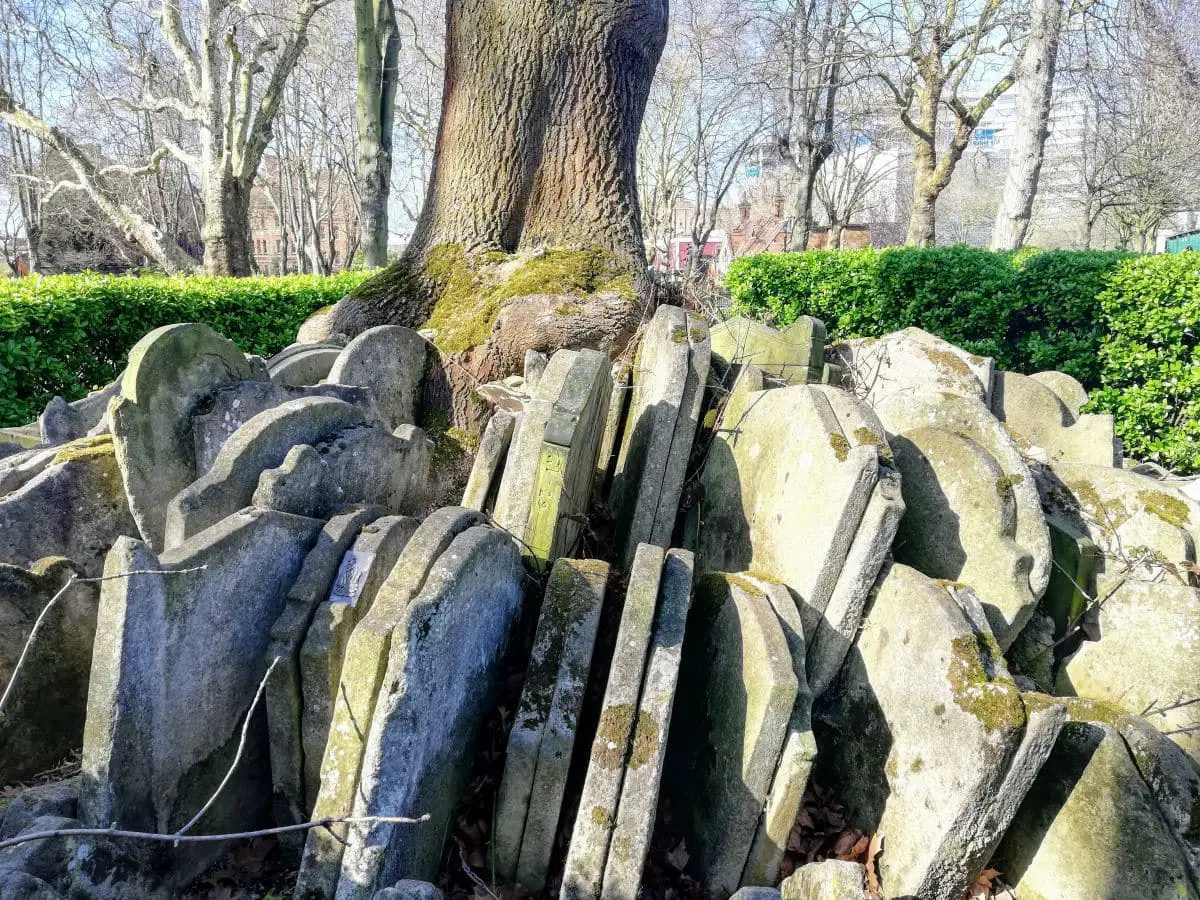
Anyone who has ever arrived in London from France, the Netherlands or Belgium on the Eurostar train will be familiar with the St. Pancras train station. What you may not have noticed, though, is the St. Pancras Old Church, one of the oldest churches in England, which sits right next to the renowned station. The church and its peaceful churchyard offer respite from the loud bustle of the station and Camden Market nearby.
A number of notable people are buried in the churchyard, including the transgender spy Chevalier d’Éon and the architect John Soane, whose mausoleum inspired the design of London’s iconic red phone booths. There are not as many graves here as there used to be, though. In the 1860s, a large section of the churchyard was dug up to make way for the train tracks of the Midland Railway line. The uprooted gravestones were lined up back to back around a big ash tree, now known as the Hardy Tree.
So why is it called that? Because the English novelist and poet, Thomas Hardy, was the one tasked with dismantling and digging up the graves, and it was Hardy who decided to leave the gravestones encircling the tree. At the time, he was apprenticed to an architect in charge of the project and had not yet taken up writing. The Hardy Tree is one of the 61 trees officially recognized as Great Trees of London.
Location: Saint Pancras Gardens, London
Cruise the Thames on an old Paddle Steamer
Explored by Annabel from Smudged Postcard
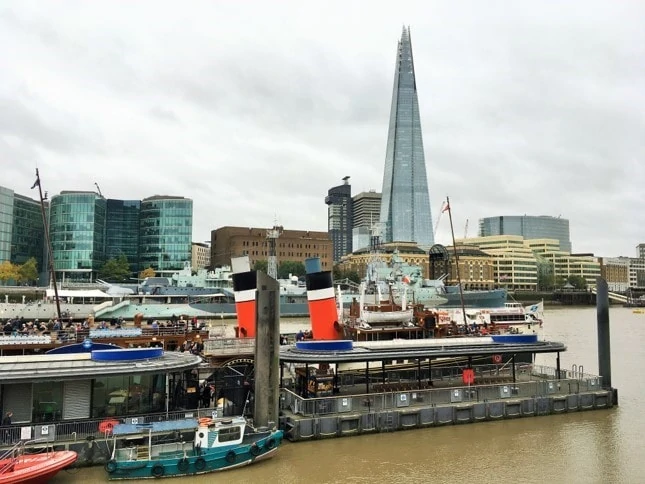
The Paddle Steamer Waverley is the last sea-going paddler steamer in the world. Take a trip on the grand old ship from Tower Pier, next to the Tower of London and you’ll take in some of the less familiar sights along the River Thames.
After passing well known landmarks such as HMS Belfast and Tower Bridge, the Waverley passes the towers of Canary Wharf before heading further east. If you have the time, you can travel all the way to the mouth of the Thames but for a fascinating half day excursion, travel as far as Gravesend in Kent (burial place of Pocahontas) before hopping on a train back to centre London.
The Waverley passes luxury apartments which belie their origins as former shipping warehouses. You’ll also pass plenty of docks and warehouses still very much in use: it’s not all history and luxury living in London. Before reaching Gravesend, the Waverley passes the ominous looking Thames Barrier used to prevent flooding in central London, no doubt it will be used more and more in coming years.
There’s also plenty to see inside the Waverley. Head down into the bowels of the ship to discover the huge engine which is on full display for all to see. There’s also a café and gift shop as well as plenty of indoor and outdoor seating.
Tiny Paintings on Millennium Bridge
Explored by Becki from Meet Me In Departures

This is probably one of the biggest hidden gems in London, that literally thousands of people walk over every day without realising it. On most people’s London bucket list there is a walk over Millennium bridge, over the famous River Thames and to get that iconic framed shot of St Pauls Cathedral.
However, this renowned landmark also hides hundreds of little hidden gems, there are actually tiny paintings all over the bridge. Over the years, millions of feet have walked over these images, most people are unaware of. They are the brainchild of the artist, Ben Wilson.
The tiny creations are made from chewing gum, squished into the grilled texture of the bridge. This then gives a surface that the artist painstakingly paints his designs on.
The more you look, the more you see. It’s impossible to count them all, and new little pieces of urban or street art are cropping up each week. When I discovered this, it took nearly an hour to cross the bridge because there were so many to look at, and I barely scratched the surface. I remember cause havoc with the regular walkers because I kept stopping every few steps to look and photograph something new.
You’ll find aliens, spaceships, city scenes, flowers and many other tiny designs.
I love little London hidden gems like this, which are right in plain sight. Unless I was tipped off, I would never have known about them. Seriously, they are definitely worth checking out on your next trip to London.
St Dunstan’s in the East
Explored by Angie from Where Angie Wanders
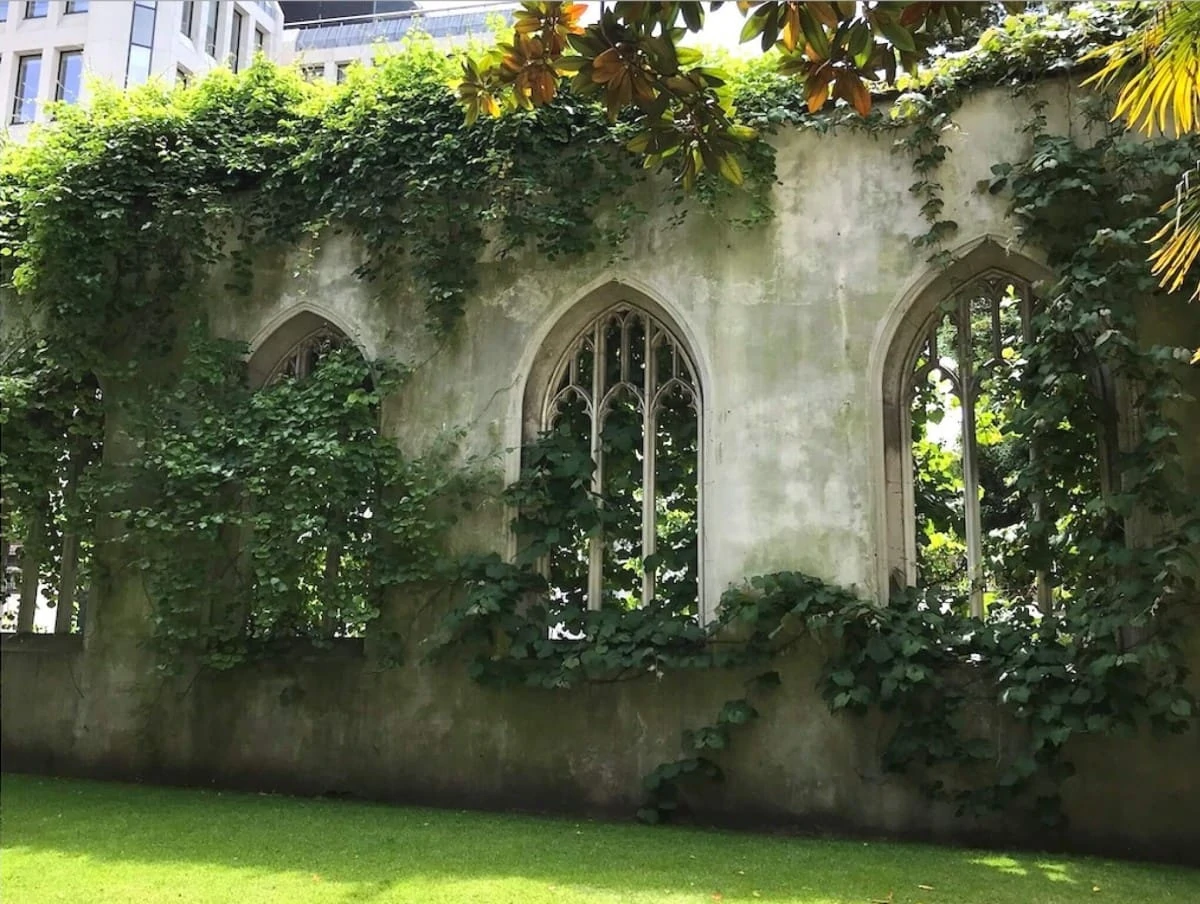
One of London’s hidden secrets is the tranquil ruins of a Gothic church known as St Dunstan’s in the East.
It lies within a stone’s throw of the Tower of London but unlike its famous neighbour is not known to tourists despite its vivid history.
Established circa 1100, St Dunstan’s has certainly weathered the storm of time and has had additions and repairs made over the centuries.
The Great Fire of London in 1666 saw the church receive considerable damage and while it was initially patched up, the architect Sir Christopher Wren stepped in some years later to design the tower and steeple we can admire today.
Bombing raids on London during the second World War also took their toll. All that now remain of the original structure are the outer walls, with their stone arched windows reclaimed over time by foliage, and amazingly the tower and steeple.
St Dunstan’s is an urban oasis for office staff that work in the skyrise buildings that engulf this tiny space. And visitors who unintentionally stumble upon its setting do not forget its allure, especially the ivy climbers that entwine themselves around the ruins.
But now this secret London gem has been shared with you, bring a sandwich, your favourite novel or even a set of paints and enjoy a respite in this magical outdoor space before you continue exploring the myriad of other great things to discover in London.
Location: St, Dunstan’s Hill, London
Open: 8.00am to 7.00pm daily
The Banqueting House
Explored by Ella from ManyMoreMaps
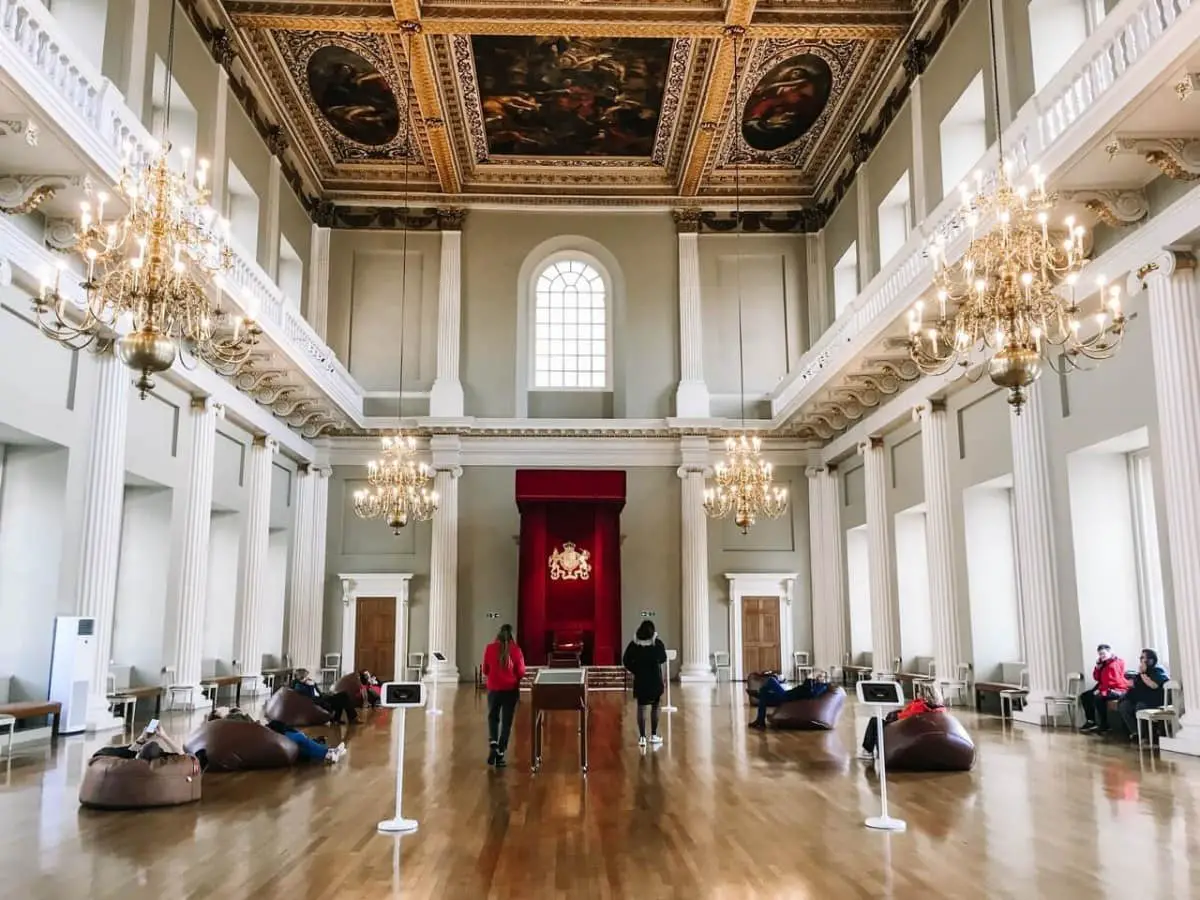
Tucked away just behind the Houses of Parliament and a few minutes’ walk from Buckingham Palace, the Banqueting House is often overlooked by tourists in favour of the more famous nearby attractions. However, for any British history enthusiasts, the Banqueting House is a must-see, and one of the secret buildings in London you have to add to your list.
The Banqueting House is the only remaining part of the Palace of Whitehall, where the British royal family resided between 1530 and 1698. Completed in 1622 by designer Inigo Jones, the Banqueting House saw countless royal receptions, ceremonies and performances take place within its walls. Undoubtedly, the reason to visit the Banqueting House is to marvel at its famed ceiling, celebrating the reign of James I. It was painted by revered Flemish painter Peter Paul Reubens, and, remarkably, survived both the Great Fire of London in 1666 and The Blitz in the 1940’s. Beanbags are scattered across the floor so you can sit back on one and listen to the audio guide as you inspect the ceiling.
The Banqueting House also has a darker history. It was on a platform outside the Banqueting House where King Charles I was executed in 1649. It was also in the Banqueting House 11 years later that Charles II (Charles I’s son) was restored to the throne.
Tickets, which include an audio guide, cost 7.50 GBP (9.25 USD), and you should allow yourself 45 minutes to look around.
Location: Whitehall, Westminster, London
Open: 10.00am to 5.00pm daily
The Barbican Conservatory
Explored by Jodie from A La Jode
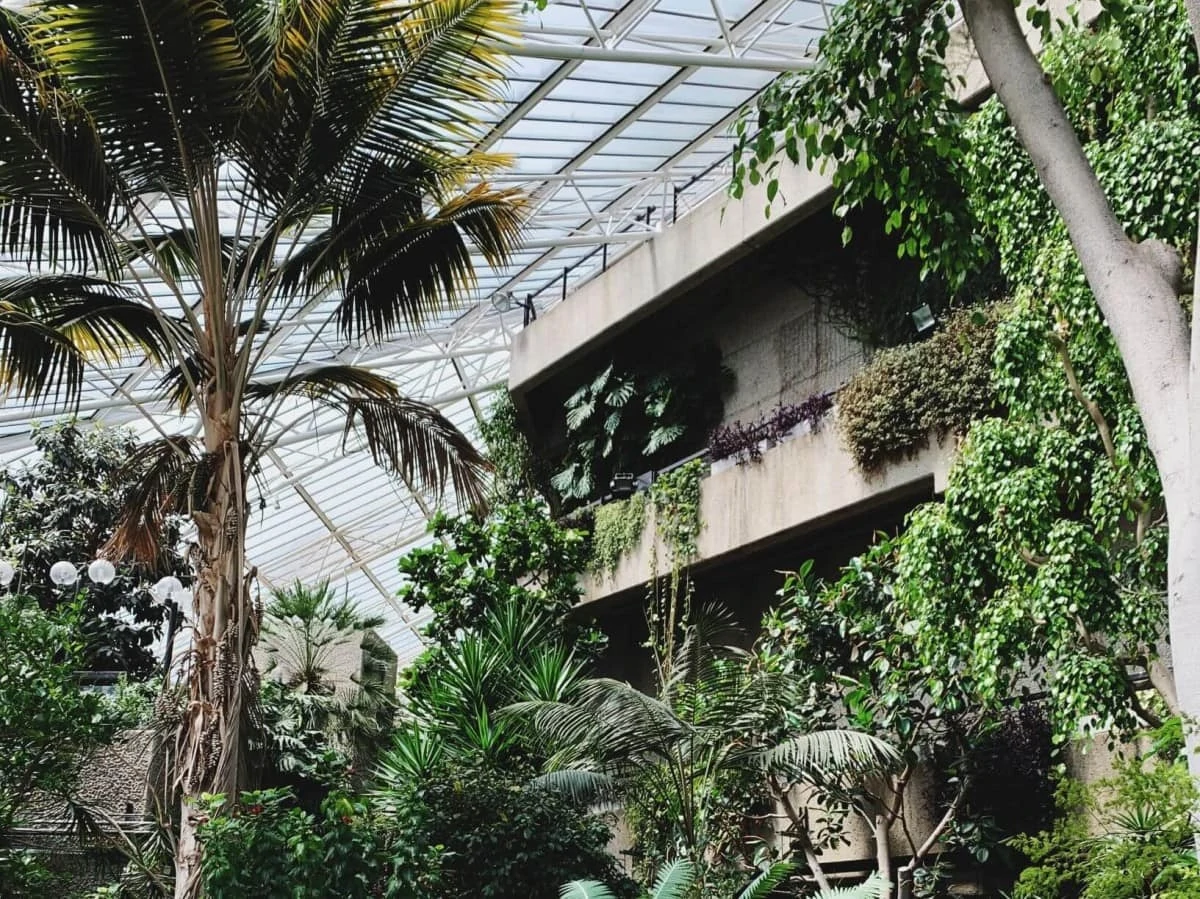
Most tourists head to Kew Gardens for a taste of nature. However, while Kew Gardens is well worth the trip, there’s another garden right in zone 1: the Barbican Conservatory. This lesser known secret spot is a real London hidden gem – both figuratively and physically. Housed in one of the ugliest buildings in London, the conservatory’s exterior gives no clue to what lies inside.
If you’re looking for non touristy things to do in London, the Barbican Conservatory is a great way to spend a few hours. Step inside and you’ll notice that most of the other people there are locals, rather than tourists. It’s completely free to visit, too, meaning it’s great for visitors on a budget.
Although it’s free to visit, the Barbican Conservatory has rather limited visiting hours. It’s usually only open on weekends and bank holiday Mondays, so you’ll need to plan your visit around a weekend. This isn’t such a bad thing though. One of the best ways to experience the conservatory is with its Sunday afternoon tea – something that many people don’t know about. Spaces are very limited, but book in for a very British afternoon tea experience surrounded by the rainforest if you can!
Location: Barbican Centre, Silk St, London
Open: Check out the opening times here.
Hampstead Heath Pergola and Hill Garden
Explored by Ellie from The Wandering Quinn
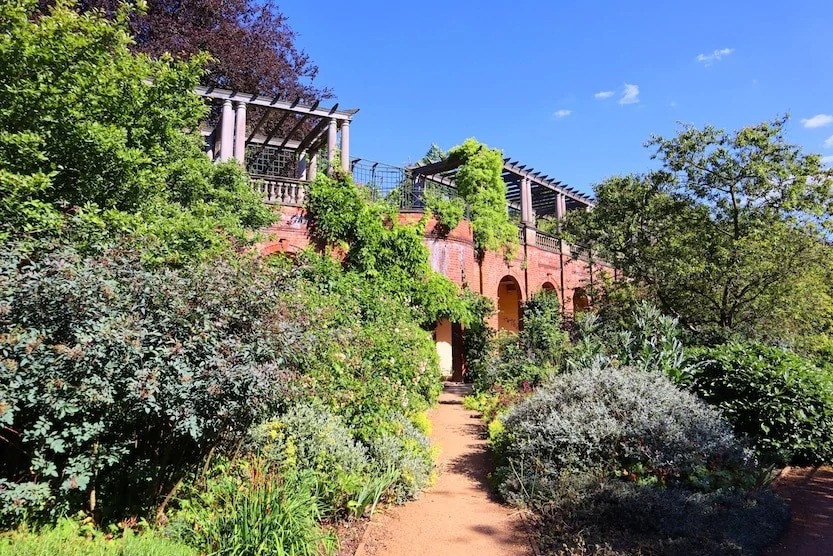
Hampstead Heath is a fairly known attraction in London, this huge park is great if you want to get out of the city for a walk in nature. And the view of London City that can be seen from Parliament Hill is incredible!
However there are plenty more things to do in Hampstead, including the Hampstead Hill Garden and Pergola, but this secret London attraction is much more hidden and unknown.
Hampstead Heath is split into two parts, most people visit the Eastern part which is home to Parliament Hill and Kenwood House, however over the road in the North-Western part is a Pergola with a beautiful Edwardian design and Gardens that were built in the early 1900s!
It was Lord Leverhulme’s vision to have a Hill Garden and Pergola in this quiet section of Hampstead that would be used for fancy dinner parties and he succeeded. However after his death, the second world war was not kind to the Hill Garden and at one point it was even used as a hospital. Following World War II, nature quickly took over the gardens and it quickly became dilapidated.
These days neither the Pergola or the Gardens are at the standard of what they once were but in my opinion that’s what makes it so special to visit and why it’s a great non touristy thing to do in London.
It is now looked after by the City of London with opening hours from 8:30 am to the late afternoon, it is free to enter and the perfect place to visit for a weekend stroll and adventure to somewhere only locals know about!
Location: The Pergola, Inverforth Cl, London
Open: Daily from 8.30am to 3.30pm
Bonus: Enjoyed the garden and pergola? Definitely add Holland Park (known for its peacocks!) and particularly the laidback Kyoto Gardens, a Japanese-inspired garden that will have you feeling zen after just a few minutes walking around.
Queen’s House, Greenwich
Explored by Noel from Travel Photo Discovery
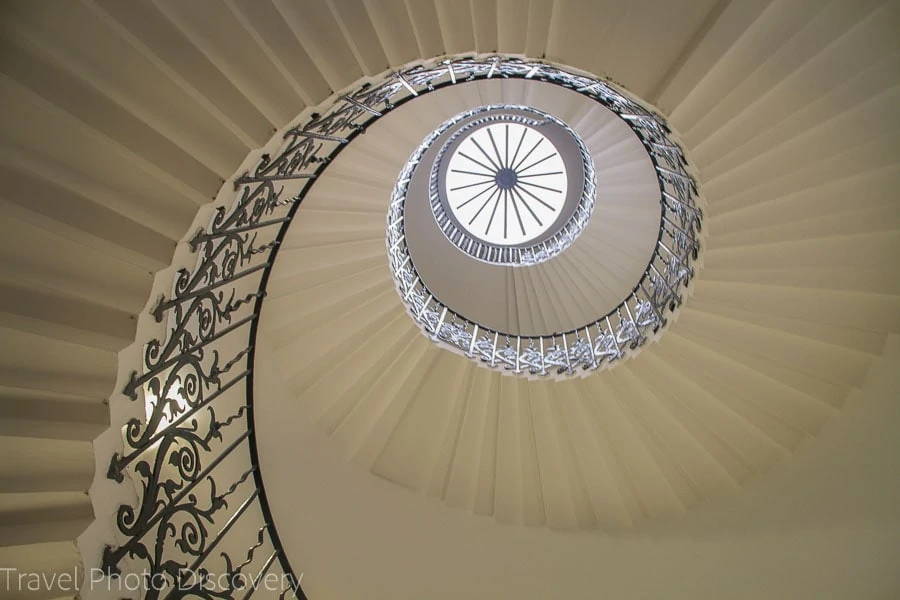
If you are looking for a cool and historic London hidden gem that also happens to be free, then head out to Greenwich to check out the Queen’s House. It’s located in a beautiful expansive park with views of the Thames and London beyond.
This historic living museum home used to be the Tudor Kings home and during maritime London’s historic rule, the area was thriving with a Maritime naval college, hospital and so many other significant places of interest.
The home is open daily and houses an impressive collection of paintings with famous local and significant artists of note. The rooms and galleries are fun to explore and even the ornate and over the top ceilings are fun to look up and check out the stunning details.
Take a leisurely tour of this magnificent home to get a better idea about its history and place along with the other significant architecture and places of interest around Greenwich. It is a fascinating blend of historic past and ultra-contemporary architecture combined.
The Queen’s House is definitely one of the best things to do in Greenwich, already a fantastic district of London to explore.
Location: National Maritime Museum Gardens, Romney Rd, Greenwich, London
Open: Daily from 10.00am to 5.00pm
The Green Chain Walk
Explored by Cassie from Cassie the Hag
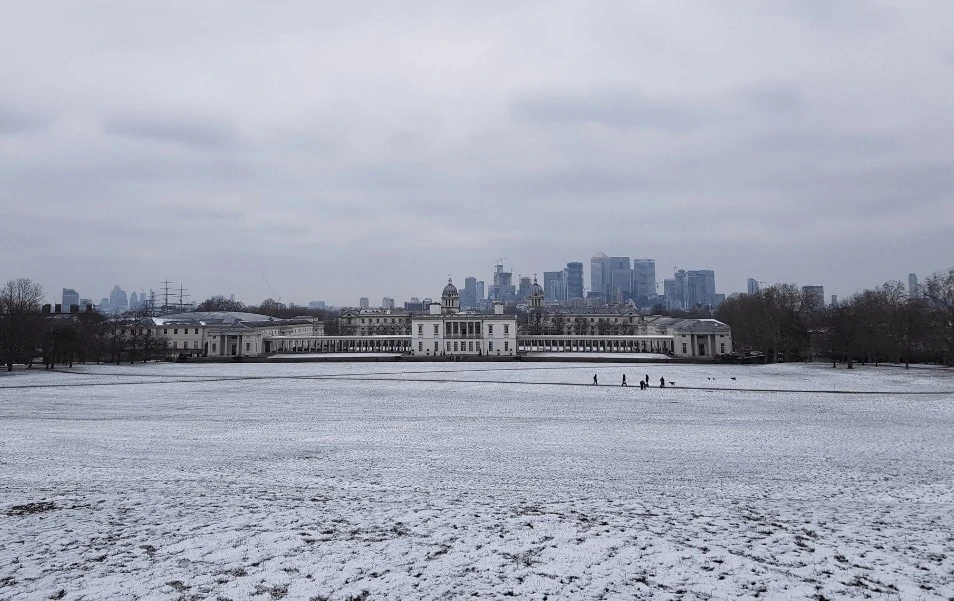
The Green Chain Walk is a great way for Londoners to unwind in the Southern suburbs and for visitors to take some time away from the tourist traps in busy seasons. Although technically 50 miles long, the walk is best split up into 11 connected sections. Depending on your preferences, you can visit 12th-century abbeys, deer parks, hidden castles and secret graffiti. And me? Although I loved my local Greenwich attractions when I lived in London, The Green Chain Walk was the only place I could really unwind. I used to enjoy heading into the woods and feeling like I wasn’t in the city anymore.
My favourite spots on the walk include medieval Eltham Palace and Gardens, which was transformed into an art-deco mansion in the 1930s – a very cool aesthetic – alongside the Crystal Palace Park dinosaurs (yes, there are dinosaurs!) and the locally famous Horniman Museum, which I promise I don’t just like just because of the name. Winding through Southeast London, it’s also a fabulous way to see what London has to offer south of the river and London’s secrets explore like a local!
My tip would be to check your route in advance and base which section you want to do around the attraction which most piques your interest.
Bonus: Hampton Court Palace
Explored by Lee from The Travel Scribes
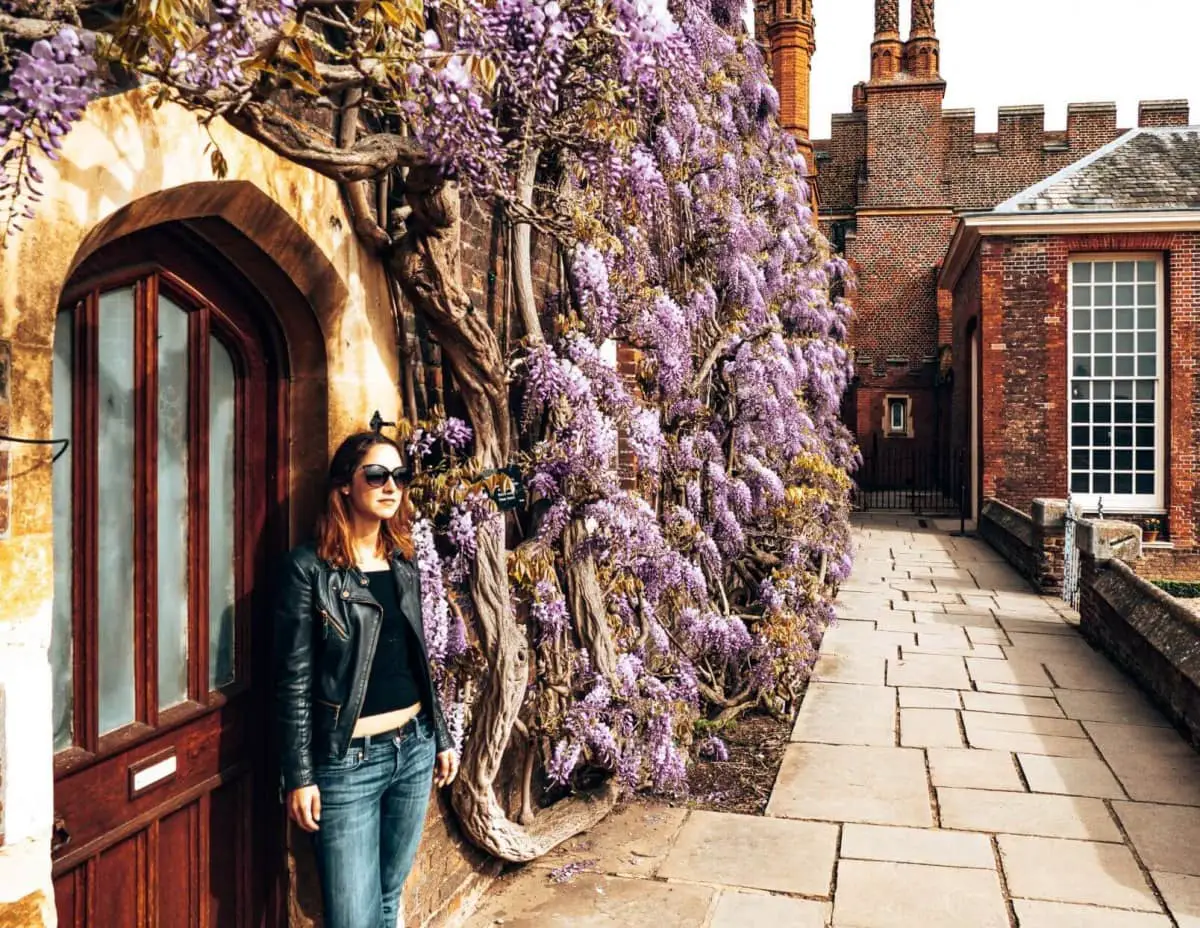
While it might not be in London’s city centre, it’s worth heading out of the city confines to see the sprawling complex of Hampton Court Palace. It’s actually near to where we live hence we had to add it as a bonus! Perched on the border of London and Surrey, this London hidden gem might be a little more touristy at times, but does a great job of delving into history, as well as offering some expansive green spaces.
First built in 1515 by Cardinal Wolsey, the Palace is most famous as the home of King Henry VIII. Yes, he of the six wives! It’s got a sordid history as Henry’s third wife, Jane, died in childbirth there and Catherine, his fifth wife, was arrested for treason and adultery on the grounds (it’s said her ghost still haunts the corridors), but it’s a gorgeous building and you can definitely time it to be a little emptier for your visit.
You can take a guided tour within the Palace walls or just spend a few hours wandering the fantastic gardens which, incidentally, are entirely free if you get there between 9.00 – 10.00am each day. The grounds has incredible manicured gardens but also a large maze constructed out of yew hedges that will give you at least 30 minutes of fun.
If you’re interested in Henry VIII, one of our top travel tips is to take a walk to the nearby Bushy Park to see the roaming deer – this is where the king used to hunt during his reign.
Hidden gems in London interactive map
So, what do you think of our list of non touristy things to do in London? Whether it’s your first time in the city or you’re just in search of the best secret places, we hope we’ve satisfied your appetite for the ultimate hidden places to visit in London!
Did we miss one off the list? Let us know in the comments below if there are more hidden gems that should have made our countdown.
Want to save this for later? Why not pin it…
